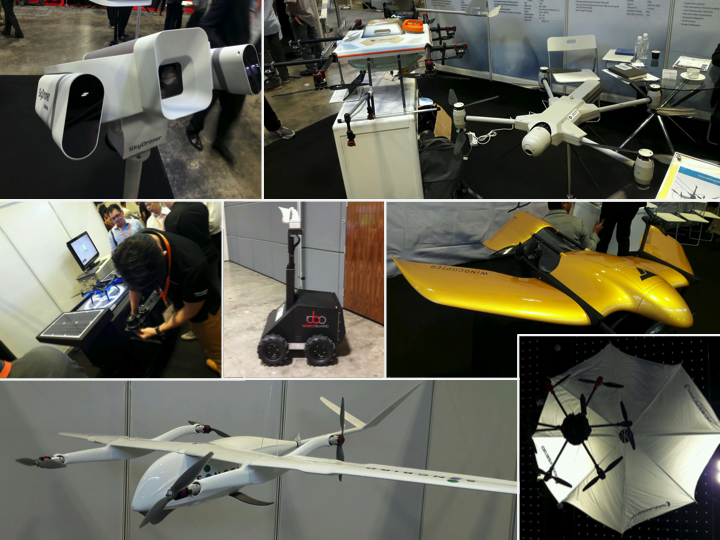
Alejandro Alonso-Puig, the CTO of Singapore UAS startup Infinium Robotics, visited and spoke at the Commercial UAV Show Asia 2016 held in conjunction with the IoT Show 2016, September 1-2, at the Suntec Convention Centre in Singapore. Puig has given permission to republish his review of the show.
The well-known companies in the Commercial UAV market, as expected, had large booths: DJI, Parrot, Yuneec, SenseFly, Aerialtronics, Tarot, showing rotary and fixed wing solutions, but also I found some other solutions in this trade fair:
- Hybrid fixed-rotary wing solutions: I saw this sort of solutions more than three years ago, but now I see they are getting mature. Companies like Aldara (Wincopter) or Aerolution Systems offered interesting machines.
- Energy: Some companies like HES, Alta Devices or Ascent-Solar offered alternative sources of energy to the traditional LiPo Batteries. I expected more companies, as the size of this market is clearly huge.
- Sense & Avoid solutions: Some companies, mainly start-ups, offered sense and avoid solutions, mainly based on tiny radar technologies, like Fortem or RAN Systems, although DJI (Guidance) and Parrot (S.L.A.M.dunk) are also in the market.
- Anti-Drone Systems: I saw only one company offering Anti-Drone solutions, what surprised me. Teleradio was offering SkyDroner, an interesting solution, able to identify the drone radio signature, hack the signal and take control of the drone.
- Other: Companies like Infinium Robotics offered solutions for Stock-Taking with autonomous drones in warehouses and Riegl offered powerful Lidars for terrain 3D Mapping between others.
I heard some people expected much more innovative solutions in this trade fair, but the reality is that the drones sector is maturing slowly, step by step. The main technical areas that require improvements are well known: flight endurance, sense & avoid (no collision), autonomous navigation in constrained areas and fail-safe reliable systems. The drone applications are available, but the former improvements are needed to give the professional drone market real exponential growth.
 Indeed, many global companies are working for this market, going after the Treasure Island promised by most of the sales forecast statistics. But an important question is how to survive to this difficult, expensive and long trip. Unfortunately, I found many companies making bad choices that may make them lose the race very soon:
Indeed, many global companies are working for this market, going after the Treasure Island promised by most of the sales forecast statistics. But an important question is how to survive to this difficult, expensive and long trip. Unfortunately, I found many companies making bad choices that may make them lose the race very soon:
- Some companies are trying to have a drone in the market that is not so different than competitors and not really cheaper.
- Some companies are trying to develop complex innovative systems from scratch, being start-ups with not much funds. Developing anything for this market is expensive and requires much time and effort.
- Some companies build complex systems that the users are not willing to pay for. Maybe because they are very expensive for what the customers really need, or because the target customers do not have the funds for such investments. Therefore the amounts of units sold are very low, not recovering the investment.
- Some companies develop solutions that are non-scalable and do not pay attention to international markets.
- Some companies develop local solutions in countries with very restrictive laws for aerial navigation and therefore sales are far less than expected.
- Some companies lose much time and energy in tailor made solutions for “important” customers that at the end do not give enough incomes, are not scalable, and require a lot of personalized support.
- Some companies project in their business plans that they will sell many units of their top quality, highly efficient but expensive systems the first year, but the reality is that in the majority of the cases, first year sales are low, as potential customers prepare their financial plans on a yearly basis, so they may not invest in expensive systems as soon as expected.
- And last but not least, some companies do not value correctly the customer support and maintenance requirements for their products and get overwhelmed with the amount of support required from customers, “bleeding” much time and money.
This is a new technology, still in its infancy, in a world that is becoming more and more global and commercially hungry and aggressive. Companies need to strategically plan and carefully execute to compete in this market.





Tell Us What You Think!